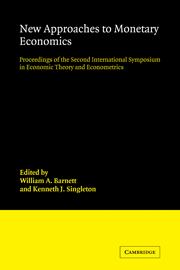 New Approaches to Monetary Economics
New Approaches to Monetary Economics Book contents
- Frontmatter
- Contents
- Editors' introduction
- List of contributors
- Part I Transactions motivated monetary holdings in general equilibrium
- Part II Financial intermediation
- Part III Monetary aggregation theory
- 6 The microeconomic theory of monetary aggregation
- 7 Monetary asset separability tests
- 8 Money demand in open economies: a Divisia application to the U.S. case
- 9 Aggregation of monetary goods: a production model
- 10 Money in the utility function: an empirical implementation
- 11 Comment on papers in Part III
- Part IV Issues on aggregate fluctuations
- Part V Theoretical issues in the foundations of monetary economics and macroeconomics
10 - Money in the utility function: an empirical implementation
Published online by Cambridge University Press: 04 August 2010
- Frontmatter
- Contents
- Editors' introduction
- List of contributors
- Part I Transactions motivated monetary holdings in general equilibrium
- Part II Financial intermediation
- Part III Monetary aggregation theory
- 6 The microeconomic theory of monetary aggregation
- 7 Monetary asset separability tests
- 8 Money demand in open economies: a Divisia application to the U.S. case
- 9 Aggregation of monetary goods: a production model
- 10 Money in the utility function: an empirical implementation
- 11 Comment on papers in Part III
- Part IV Issues on aggregate fluctuations
- Part V Theoretical issues in the foundations of monetary economics and macroeconomics
Summary
Abstract: This paper studies household asset demands by allowing certain assets to contribute directly to utility. It estimates the parameters of an aggregate utility function that includes both consumption and liquidity services. These liquidity services depend on the level of various asset stocks. We apply these estimates to investigate the long- and short-run interest elasticities of demand for money, time deposits, and Treasury bills. We also examine the impact of open market operations on interest rates, and present new estimates of the welfare cost of inflation.
This paper studies households' demand for different assets by allowing certain assets to contribute directly to household utility. We permit the utility function to capture the “liquidity” services of money, certain time deposits, and even some government securities. Our approach yields estimates of the utility function parameters which can be used to study the effects of a variety of changes in asset returns. We investigate how asset holdings and consumption react to both temporary and permanent changes in returns, and study the effects of government financial policy.
Our approach provides an integrated system of asset demands of the form that Tobin and Brainard (1968) advocate for studying the effects of government interventions in financial markets. It provides a tractable alternative to the atheoretical equations that are commonly used to study the demand for money and other assets. Those equations, which cannot be interpreted as the rational response of any economic agent to changes in the economic environment, are unlikely to remain stable when the supply of various nonmonetary assets changes.
- Type
- Chapter
- Information
- New Approaches to Monetary EconomicsProceedings of the Second International Symposium in Economic Theory and Econometrics, pp. 219 - 240Publisher: Cambridge University PressPrint publication year: 1987
- 29
- Cited by
